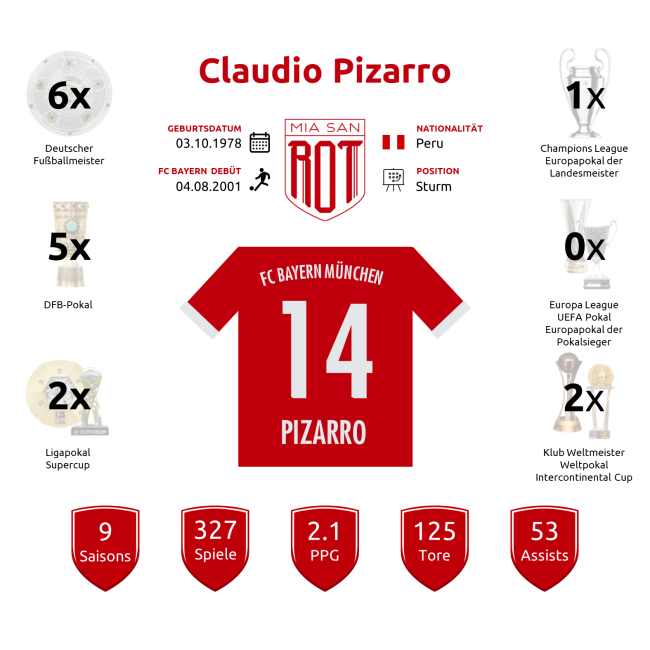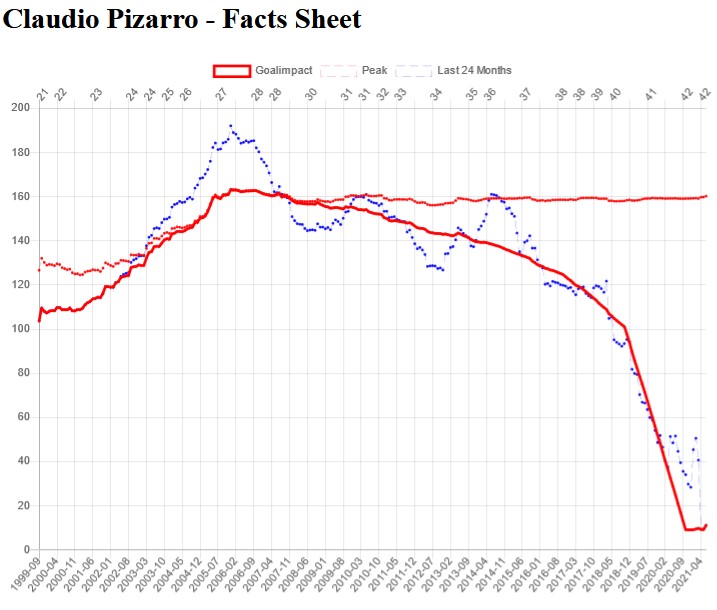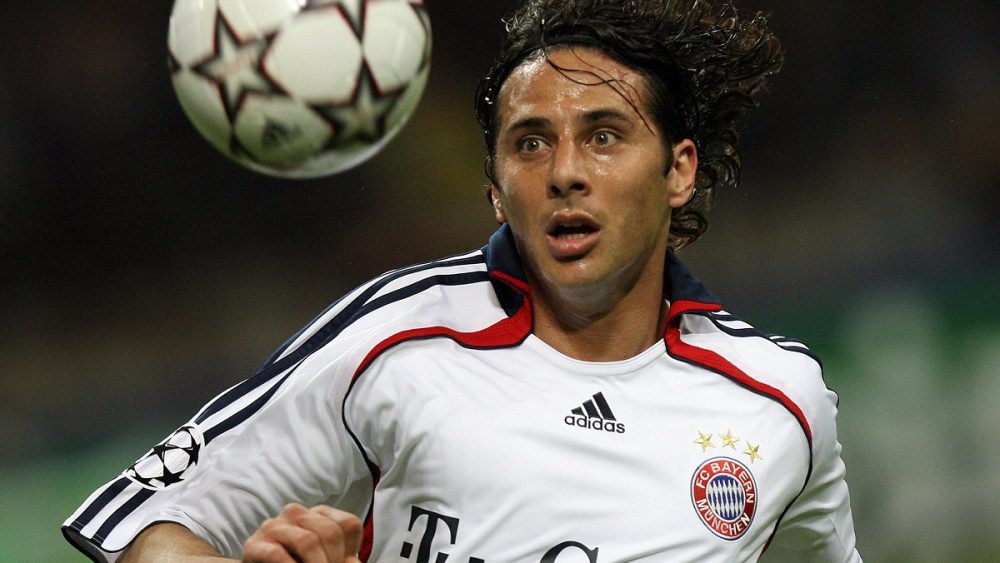FC Bayern – Miasanrot Advent Calendar, Door 14: Claudio Pizarro
A guest article by Alex Feuerherdt.
In March 2016, sports journalist Thomas Nowag tweeted a photo showing Claudio Pizarro and Pope Francis, taken in October 2014 at the Vatican. In the captions, Noway had printed a fictitious dialogue between the two men on the photo: “I admire you. Your dignity and charisma is inspirational for billions of people.” – “Thank you, Holy Father.” A tribute to the striker that was as amusing as it was, of course, entirely appropriate and even more so under-apprciated by the Twitter community having garnered a mere 1,400 likes and just over 400 retweets.
Claudio Miguel Pizarro Bosio, as he is known by his full name, finally called an end to his career as a professional footballer after the 2019/20 season at the age of almost 42. When about two years later – when Corona no longer caused the stands to remain empty – he played his farewell match in front of 42.000 spectators in Bremen’s Weser Stadium, the fans of two clubs may have shed a tear or two: those of FC Bayern, where Pizarro had two successful stints, and those of SV Werder Bremen, which he singed for no less than four times.

He played almost the same number of competitive matches for both clubs: 327 times for FC Bayern and 320 times for Bremen. He scored 125 goals for Munich and 152 for Werder. However, Pizarro only won one title with the northern Germans, namely the DFB-Pokal in 2009, whereas he was a six-time champion and five-time cup winner and also won the Champions League once with Bayern. He also holds several records: Claudio Pizarro is the foreign player with the most Bundesliga appearances, the oldest Bundesliga goalscorer, the first player in the history of Germany’s first division to score at least one goal in 21 consecutive calendar years, and SV Werder’s record goalscorer.
DISCOVERED RATHER BY ACCIDENT
But these bare figures, impressive as they are, only tell part of the story. Even how Pizarro came to the Bundesliga was something special, because he was discovered rather by chance – the scouting system in the late 1990s was nowhere near as professional and close-meshed as it is today. In 1999, Werder’s then managing director Jürgen L. Born still worked for the German Development Company, his former employer, in Peru and remembered that he had noticed a young attacker from Alianza Lima during the broadcast of a Peruvian national team match.
So, on his own initiative, he went to a training session of the club, which, however, was taking place that day behind closed doors. Born therefore had to squeeze through a hole in the fence and hide behind a pillar to watch Pizarro. “But I didn’t have to look very long, because I could immediately recognise his smooth movements, his speed and his coolness in front of goal. I was sure: this is one for Werder,” he later recalled. Born flew to Lima once again with the then Bremen sporting director Klaus Allofs to see the then 20-year-old. Pizarro was then signed by SV Werder.
PREVAILING AGAINST RENOWNED RIVALS
He hit the ground running at Werder, scoring a total of 29 goals in his first two years in the Bundesliga and also scoring regularly in the Europa League. It was clear that he also attracted the interest of FC Bayern, who signed him for the 2001/02 season for a fee of €15 million Marks – after a turbulent and nerve-racking season in which the Bayern team won the championship in literally the last second and a few days later also the Champions League on penalties. From then on, Pizarro’s rivals were Giovane Élber, Carsten Jancker, Paulo Sérgio, Alexander Zickler and Roque Santa Cruz.
But Pizarro also asserted himself at his new club, scoring 15 times in the Bundesliga in his first season and being used in all Champions League matches of the defending champions until their elimination in the quarter-finals. He stayed with FC Bayern until 2007, when he turned down the offer of a contract extension and moved on a free transfer to Chelsea FC, where he did not manage to kick on at all. After just one year and only two league goals, Pizarro returned to Bremen, first on loan and then permanently.
ASTONISHINGLY ACCURATE EVEN AT A RIPE OLD AGE
For the 2012/13 season, he moved from Bremen to Bayern for the second time, now almost 34 years old. It was clear that Pizarro would only be number three in attack behind Mario Mandžukić and Mario Gomez and would mainly be used as a substitute. But he gladly accepted this role in the late autumn of his career. “He’s a sly one, but with me he’s always professional, willing to perform and powerful. He is also a great character, always a positive element for a team,” recalled Jupp Heynckes later, who coached the team in that season and led it to the treble of championship, DFB-Pokal win and Champions League victory.
Claudio Pizarro scored regularly when he came on – three times in the Champions League group match against OSC Lille (6-1), even four times in the Bundesliga match against HSV (9-2). The reward: the club extended the one-year contract for another year and, after ten Bundesliga goals in 17 appearances under Pep Guardiola, for another season in the 2013/14 season, in which Pizarro, however, hardly played and remained without a goal for the first time. At the age of almost 37, he moved to Bremen for a third time, where he played a total of 32 competitive games in the 2015/16 season, scoring 16 times. A remarkable rate at that age.

After a one-year intermezzo at 1. FC Köln in the 2017/18 season, his last move was to SV Werder. Aged 40 years and 227 days, Pizarro, who earned 85 caps for Peru and captained the national team for many years, scored his last Bundesliga goal on 18 May 2019: the winning goal to beat RB Leipzig 2-1. In the 2019/20 season, he remained goalless in 18 appearances in the championship. In mid-September 2020, Pizarro signed a contract as an ambassador for FC Bayern Munich, and of course he is also a permanent member of the FC Bayern Legends.
RASCAL AND DEVOTED TEAM PLAYER
The fact that Claudio Pizarro was still scoring in the Bundesliga at the ripe old age of beyond 40 is not only due to his good physique, but also and above all to his outstanding technical skills and his excellent anticipation and speed of action. Mehmet Scholl once called him the best footballer he had ever played with. “I watch a lot, and then I know what I can do,” Pizarro himself once replied when asked about the secret of his success. That was to say: he constantly looked around the pitch, tried to anticipate game situations in order to be one step ahead of his opponents, both mentally and literally.
Thomas Schaaf, his first coach in Germany, said of Pizarro: “Claudio is a total team player and socialite in a positive sense – just by his smile and optimistic demeanour.” His integration, he said, came from himself, “not only on the pitch”. Uli Hoeneß, who had mocked Pizarro as a “poor man’s Santa Cruz” when he first moved to Bremen in 1999, was later to call him a “rascal”, which he rightly understood as a compliment.
However, there are not a few who believe that Pizarro could have achieved even more in his career if he had spared himself many an escapade off the pitch. In Munich, he was caught twice within a year driving with a blood alcohol level of 1.1, and in Peru there was a veritable sex scandal involving him and other national players. Claudio Pizarro smiled it off, no one was permanently cross with him for it, he came across as too likeable in public, as someone who meant no harm. Other players were booed after their move to FC Bayern, but in Bremen they didn’t resent his move and welcomed him back with open arms. But then, “Piza” was really a very special player.









